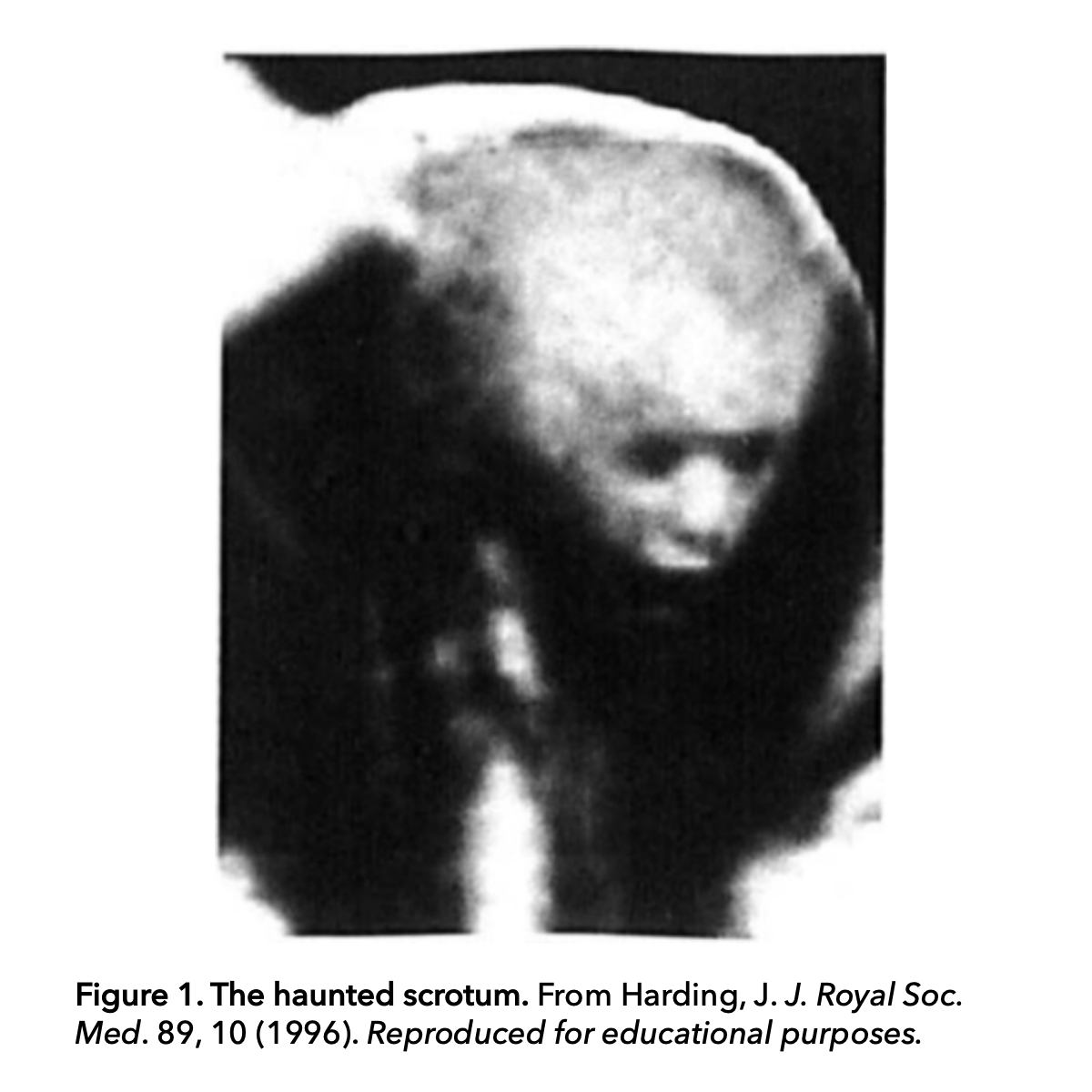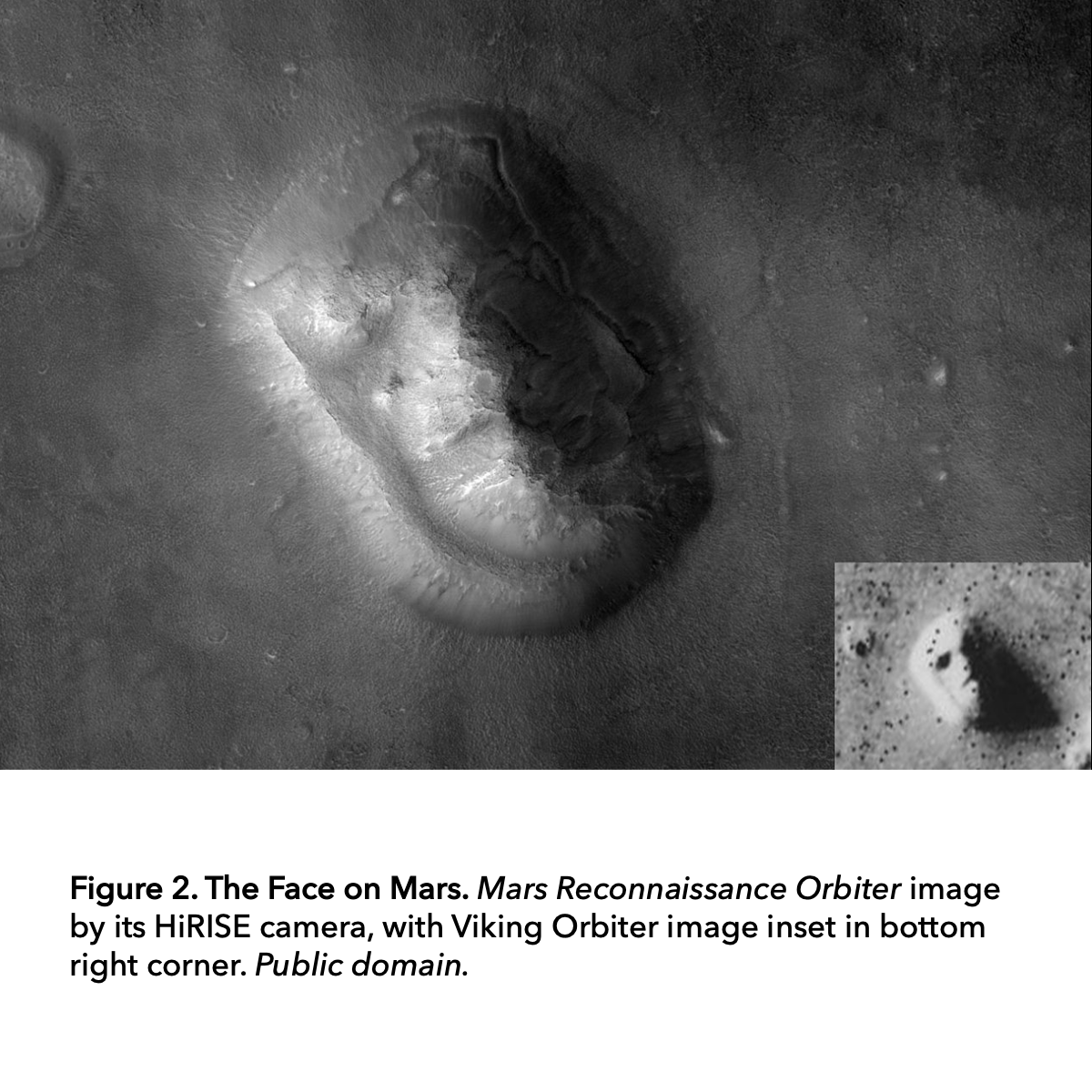Have you ever seen a haunted scrotum? It looks like something out of a David Cronenberg movie. The dark eyes, the enlarged head, the mouth covered in darkness that might be screaming! It was described by a radiologist in Wales in 1996. A 45-year-old patient had an undescended right testis and when the radiologist looked at a CT scan of the left side of the man’s scrotum, he saw “a screaming ghost-like apparition.” As he concludes humorously in his published case report, “if you were a right testis, would you want to share the scrotum with that?”

Obviously, there is no face in that man’s scrotum but our brain is easily fooled. We have a tendency to see patterns in images, objects, even sounds and music that are not truly there. This phenomenon is known as pareidolia.
A very common type of pareidolia is seeing faces that don’t exist. The haunted scrotum is a particularly oddball example, but you may be better familiar with the Face on Mars. When the Viking 1 orbiter was flying above the red planet in 1976, it took a photo of a hill-like structure on the surface that looked like a half-lit face staring back at the camera. This was no sign from the Martian welcoming committee; rather, it turned out to have been a trick of the light that combined with our brain’s ability to see faces everywhere. Better photos by the Mars Reconnaissance Orbiter in 2006 allowed us to face the facts: there was no face after all.

People have reported seeing the Virgin Mary on a decade-old grilled cheese sandwich, a perplexed face on a wall, even a fleeting echo of Vladimir Putin’s face in a flock of birds caught on camera in New York City. We’re all susceptible to it, probably because recognizing faces is so important to human life (especially when we are young and depend on our caregivers). It’s probably better for our survival to see a face where there is none than to miss seeing the face of an actual human being (or predator).
Some of us, as it turns out, are “better” at spotting non-existent faces than others. There is some evidence that people who believe in the paranormal (e.g. telepathy and astrology) are more likely to see faces where there are none than people who are skeptical of paranormal claims. This meshes with previous studies demonstrating that paranormal believers find it easier to spot patterns in noise or ambiguity, but these patterns are not actually there.
And it’s not just images that can cause illusions in our brain. Readers of a certain age will be quite familiar with the claim that playing Led Zeppelin’s song “Stairway to Heaven” backwards reveals Satanic messages like “there was a little tool-shed where he made us suffer, sad Satan.” The message is particularly clear when you read it as you are listening to the backwards song, since your brain can anticipate this verbal pattern in the noise. It would be easy to denounce the band as being in bed with the Devil (as some did at the time), but a little knowledge of pareidolia reveals what is actually happening. To complicate things, some bands do plant backward messages in their music, a trick known as backmasking, in which case pareidolia is not to blame!
But while it’s important to realize that our brain can lie to us about what it sees and hears, there is a way to turn this flaw in our brain into a memory aid. Medical students are taught to sometimes rely on pareidolia to spot signs that may indicate disease. For example, a particular X-ray of the spine can show signs of bone destruction due to metastatic cancer, but the image can be difficult to parse. It becomes easier when the student is told to look for a winking owl. The owl’s open eye is an intact pedicle (a stub of bone), while its winking eye is the absent pedicle on the other side. A complicated X-ray thus turns into a quest to see if the winking owl is there.
Owls are certainly cute but they don’t hold a candle to Baby Yoda. A team of doctors from Rutgers New Jersey Medical School recently commented that medical imaging of our sacrum, the shield-shaped bony structure connected to our pelvis, makes it look like the famous character from The Mandalorian TV show. By recognizing Baby Yoda’s face in a patient’s sacrum, they might be better able to spot the erosion of certain joints or certain types of cysts, the doctors argued.
Whether or not telling medical students to look for winking owls and cute alien puppets is truly beneficial is still up in the air. The very first test of using pareidolia in radiology education was published last year, and while the results are not overwhelming, they provide some evidence that students who are taught to look for these “metaphoric signs” do a little bit better on a quiz four days later than those who are taught more plainly, on average. They also report being more interested in the material.
Our brain is imperfect and we have to be wary of the false impressions it can conjure up. But in certain contexts, these imaginative illusions can prove quite useful.







